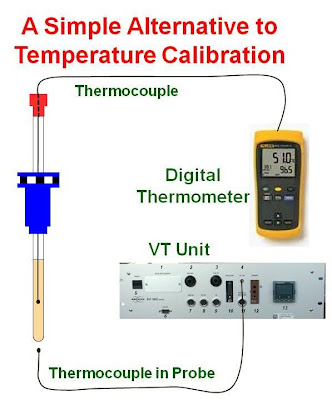Temperature Calibration - An Alternative Method
It is well known that the actual temperature of a sample in an NMR probe is not necessarily the same as that read from the variable temperature unit on the spectrometer. This is because the thermocouple used by the variable temperature unit is below the sample tube and not in the center of the rf coil where the NMR measurements are made. One normally must make a calibration plot for the actual temperature vs. the set temperature. For temperatures above room temperature this can be done by employing the known temperature dependent chemical shift difference between the two proton resonances of ethylene glycol (
see this link). At temperatures below room temperature, the same measurement can be made for the known temperature dependent chemical shift difference between the two proton resonances of methanol. The actual temperature is determined from the chemical shift difference and plotted against the temperature read from the variable temperature unit. One potential problem with this method is that the resistance of the magnet shim coils change slightly with temperature affecting the shim currents and the NMR line shapes of the resonances. This makes it difficult to measure a precise chemical shift difference. In order to obtain reliable results, the magnet must be reshimmed at each temperature.
I have used is a very simple alternative method for calibrating the temperature of the sample compared to that of the variable temperature unit. This is illustrated in the figure below.

A "sample" is prepared by pushing a NONMAGNETIC thermocouple through an NMR tube cap. The depth of the thermocouple is adjusted such that when the cap is put on the NMR tube, the tip of the thermocouple sits in the center of the rf coil. The NMR tube should contain a suitable liquid filled to the correct depth. The tube is placed in the spinner and set to the proper depth with a depth gauge. While holding onto the thermocouple, the sample is lowered into the magnet until it sits correctly in the NMR probe. The thermocouple is connected to a digital thermometer (some of these devices can use a second thermocouple in an ice water bath as a reference). The desired temperature is set on the variable temperature unit. When the temperature on both the variable temperature unit and digital thermometer have stabilized (~ 10 minutes), the values from each are recorded. This is repeated for temperatures over the desired temperature range and a calibration plot is constructed. Shimming is not an issue. Note that no NMR measurements are made and that the sample tube is not spinning.



Source:
University of Ottawa NMR Facility Blog